Feb. 24, 2023 —
[Editor’s note: In 1992, Yeoman Senior Chief Vince Patton (later MCPOCG #8) interviewed retired Commissary Steward First Class Alphonzo F. Barbour and published this story in th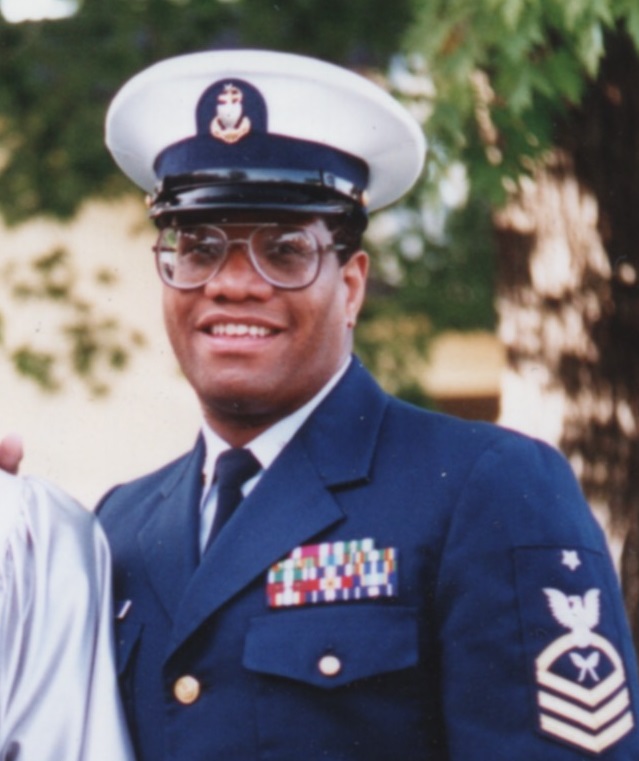 e Commandant’s Bulletin magazine. Barbour was born in 1892, turned 100 years old in August 1992 and passed away that November, just a few months after this interview. He was interred with honors at Arlington National Cemetery.]
e Commandant’s Bulletin magazine. Barbour was born in 1892, turned 100 years old in August 1992 and passed away that November, just a few months after this interview. He was interred with honors at Arlington National Cemetery.]
Retired Stewards Mate Second Class Alphonzo Ferdinand Barbour waited patiently for the knock on the door from two Coast Guardsmen who stopped by to pay him a visit. Emma, his housekeeper, greeted the men. She smiled and pointed, “Mr. Barbour is anxiously awaiting you.”
Barbour was waiting in his white messman’s uniform, proudly displaying his Good Conduct Medal and other awards, sitting at attention, just a few days shy of his 100th birthday (Aug. 22)
Barbour retired from the Coast Guard Sept. 1, 1941 and represents the earliest living linkage of black history in the Coast Guard. He endured a Coast Guard career in which seeing blacks above the rank of first-class petty officer was unique, if not surprisingly odd.
Barbour enlisted in the Coast Guard June 10, 1924, in his hometown of Washington, D.C., after spending almost four years in the Navy, serving in World War I as a mess attendant first class (E-3).
“I really loved the sea, especially after spending a few months working on my sister’s farm near Richmond, Virginia,” Barbour said. “I wasn’t afraid of hard work, but the smell of those animals and get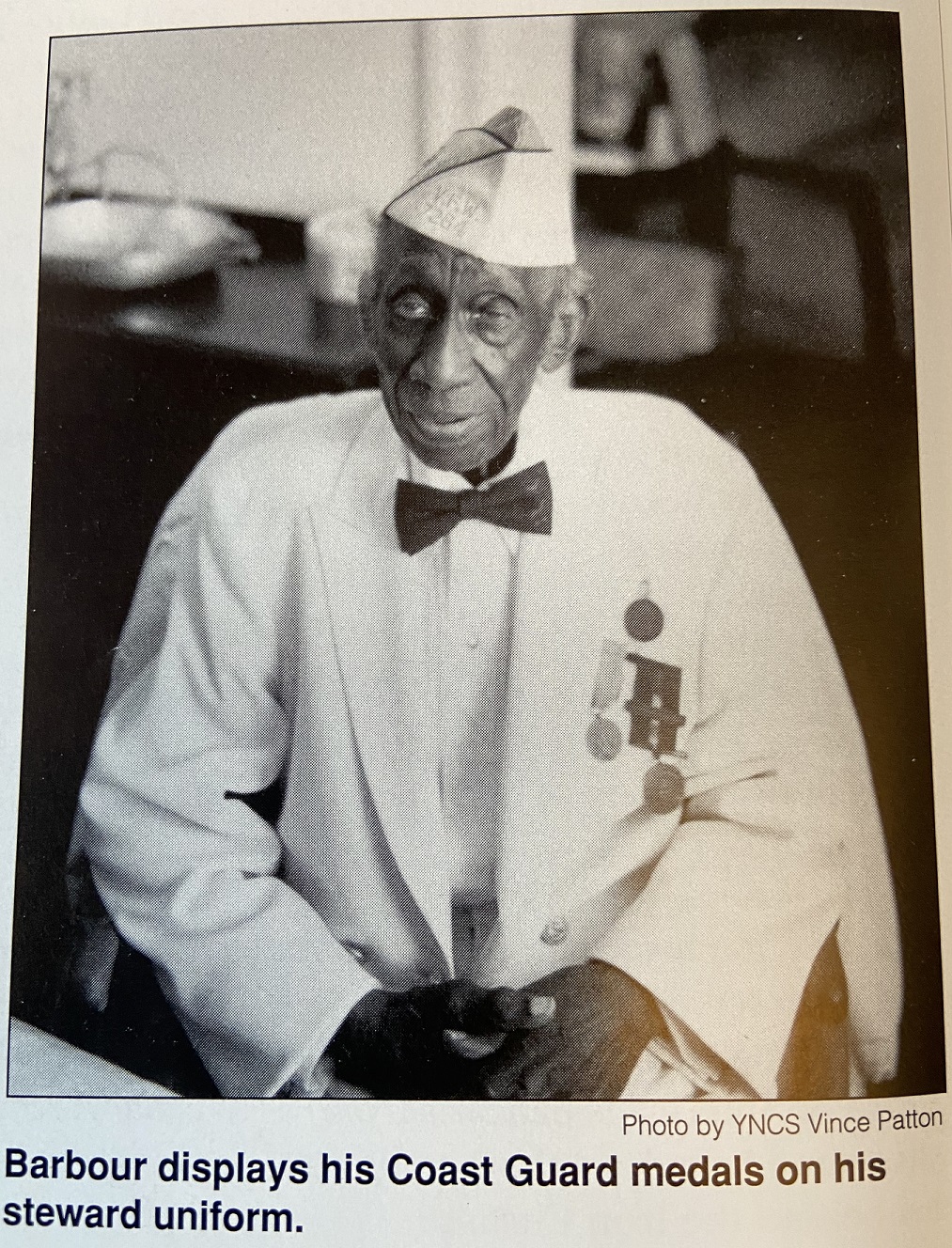 ting dirty all day was not too thrilling for a city boy like me.”
ting dirty all day was not too thrilling for a city boy like me.”
Before he joined the Navy, Barbour completed chiropractor’s school in Washington. After having a difficult time trying to find work as a chiropractor, he convinced a Navy recruiter to let him enlist by offering him a free chiropractic treatment.
That’s where his love for the sea began.
After serving aboard a destroyer in World War I, where he was a mess attendant for the officers’ wardroom, Barbour began reading fascinating stories of the Revenue Cutter and Life-Saving Services.
Barbour said he became intrigued with the numerous rescues and law enforcement missions of the two services.
“I read about this station on the Outer Banks manned completely by coloreds,” Barbour said. “If I didn’t read it myself, I would have never believed it. Imagine that--a lifesaving station with nothing but coloreds. I used to wonder what the people who were saved by them thought.”
The station was the former Pea Island Lifesaving Station in North Carolina.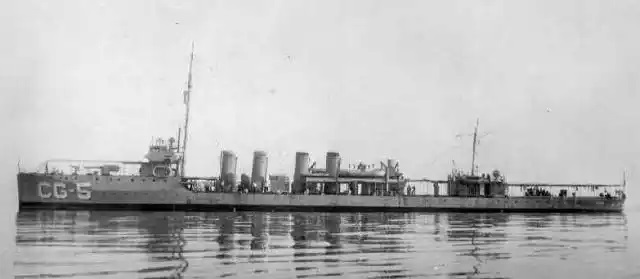
Within months after reading that story, the Lifesaving and Revenue Cutter Services merged to become the Coast Guard. Barbour started setting his goals on becoming a Coast Guardsman.
“I kind of knew that I might end up as a messman, but at least I knew that I could someday meet those guys at that lifesaving station,” he said.
Barbour’s initial experience in the Coast Guard wasn't so pleasant. “I used to go down to (the recruiting office at) the old post office downtown, and see if they would let me in,” he said. “I would go down at least once a week, sometimes every other day.”
This went on for a couple of years until finally the recruiter allowed him to enlist.
“I guess he wanted to know how bad I wanted to join,” Barbour said.
“Life in the Coast Guard was difficult for blacks during the 1920s and ‘30s,” Barbour said.
“I had a hard time trying to get along with the crew, mostly because I was usually the only colored man in the unit,” he said. “Sometimes it bothered me, but most of the time it didn’t. There was a sort of a code during those times when the rest of the cre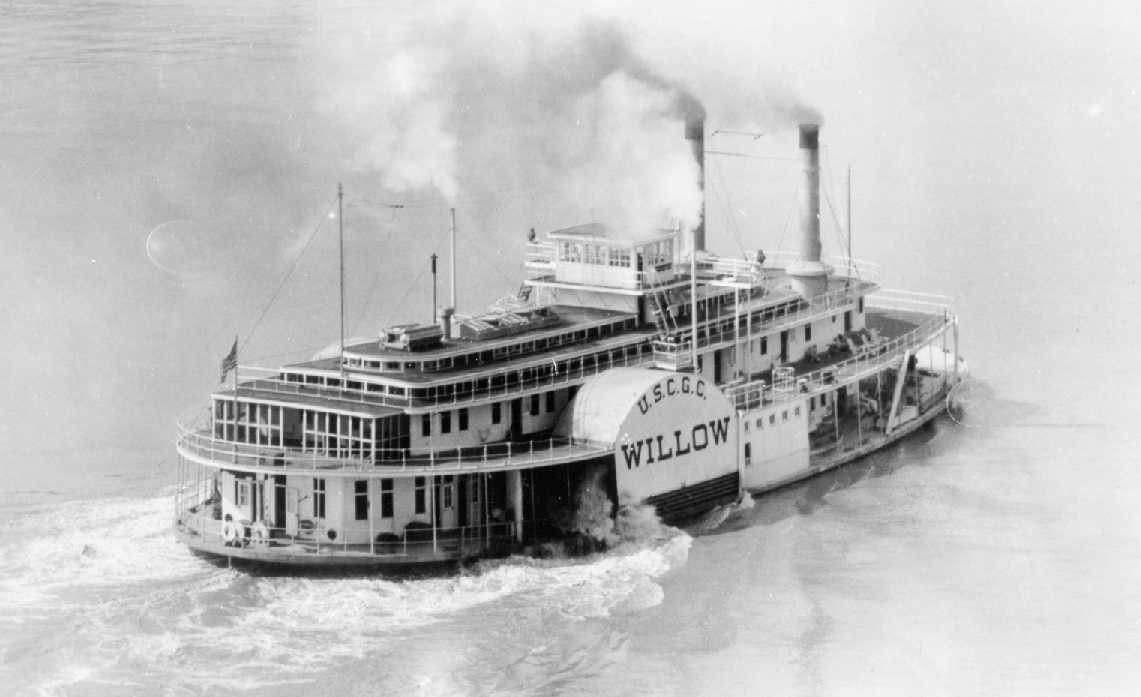 w would deal with the messman. It was usually strictly business. I got used to it because that was the way it was back then. Sometimes I felt like I was treated better than if I was a civilian. Because I would work directly for the captain, some of the white fellas would almost treat me with the same respect as the captain, except I didn’t get any salutes.”
w would deal with the messman. It was usually strictly business. I got used to it because that was the way it was back then. Sometimes I felt like I was treated better than if I was a civilian. Because I would work directly for the captain, some of the white fellas would almost treat me with the same respect as the captain, except I didn’t get any salutes.”
Since his retirement in 1941, Barbour lost his eyesight to glaucoma. However, that hasn’t slowed him down.
He’s been very active with the Veterans of Foreign Wars post in Washington, reminding everyone that he is and always will be a Coast Guardsman.
He keeps in touch with the happenings of the Coast Guard by having his friends and housekeeper read articles from magazines and newspapers about the Coast Guard.
Barbour said he “never heard of Alex Haley until after he wrote that book [“Roots”], which was kind of surprising since he came in in ‘39. There were probably a handful of us that we could count on both hands and feet. I would talk with some of the stewards from the other cutters and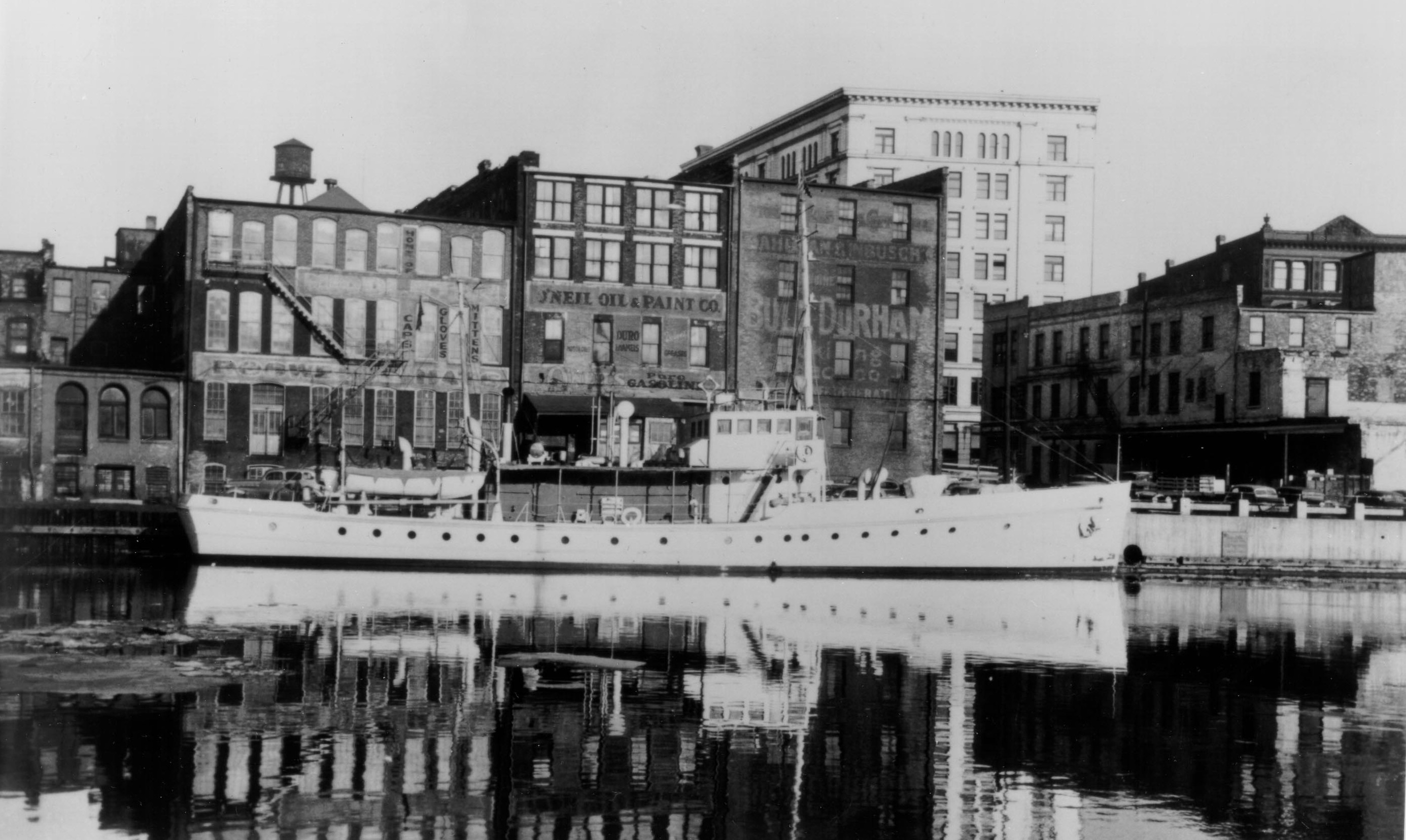
units whenever our ship pulled in somewhere. We would trade names and addresses as our form of camaraderie. Haley’s name never came up back then. Besides, he was a young sea pup at that time, and didn't get into our system yet.”
During his career, Barbour served on the Coast Guard cutters Ericsson, Corwin, Diligence, Frederick Lee, Antietam, and the Willow, and at Station Wilmette Harbor, Illinois, and Bases in Norfolk, Virginia, Nantucket and Woods Hole, Massachusetts, and Biloxi and Pascagoula, Mississippi.
Although he worked primarily as a steward, Barbour said he enjoyed taking part in the various seagoing evolutions during missions.
“It was very exciting during the rum-running wars,” he said. “I would be one of the guys that would handle the ammo for the guns or help to get the small boats over for a boarding. I don't remember how many rum boats we stopped and seized, but they were all exciting.”
Another assignment he had was on detached duty at Fort McNair, Washington, D.C.
“I was one of about six or seven stewards picked out from the Navy and Coast Guard to take care of some Japanese students in ‘31,” Barbour said. “We had to cook and clean for them. Neither one of us understood a lick of Japanese, but somehow, we figured out what they wanted. At some of the receptions on the fort, I would see and even serve Generals MacArthur, Patton, and Eisenhower, and even Admiral Halsey.”
Barbour said his only regret in his Coast Guard career is that “I never got to meet those colored boys at the lifeboat station.”
“I met several people who knew them, and their stories would always get me going,” Barbour said.
“If I was young enough today to join, I would tell the recruiter that I want to be sent to that station,” he said. “Going out on a surfboat is exciting, and I wanted to be a part of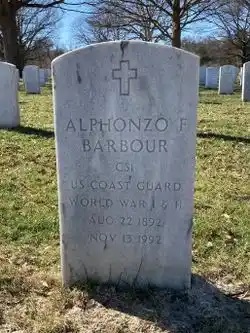 it.”
it.”
Editor’s note: The author offered a bit of background not mentioned in the article. This editor felt it was important to include Master Chief’s correspondence here to add to the humanity piece of both of these great men as well as to document more dialogue of our Coast Guard history.
Here are words from the eighth Master Chief Petty Officer of the Coast Guard, Vince Patton.
“Believe it or not, it was one of my highlights of my career to meet and talk with him!
A little background that wasn't mentioned in the article ... It was a 'by chance' opportunity meeting Mr. Barbour. It all started with a wrong number. His housekeeper was trying to find someone in the Coast Guard to get him a new ID card, because she unfortunately 'destroyed' it in a laundry wash. Mr. Barbour was quite furious with her and directed her to get it replaced right away. Poor lady thought she was going to jail for ruining his ID card!
Anyway, she was given a number for the Coast Guard through directory assistance, which turned out to be to my office. At the time, I was actually working in the Coast Guard Headquarters Performance System Division (training and education) as a senior chief yeoman. I took the housekeeper's call, and she was really distraught, I could tell that she was crying trying to explain to me about the ID card. Well, I put her at ease and told her that I would take care of it and would get in touch with our admin folks. We would come out to Mr. Barbour's home and personally type it up and issue it to him on the spot. This was back in the day when ID cards were done on typewriters, and we had a portable laminating machine.
I traveled out to Mr. Barbour's home, which was just north of Howard University, off Georgia Ave, and brought the Coast Guard Headquarters Admin yeoman chief petty officer to take care of the ID card business. As mentioned in the article, Mr. Barbour dressed up for us, and acted like he was greeting the commandant, or maybe even the president. So, the chief and I spent about two hours with him, listening to some amazing sea stories he had about his vintage Coast Guard career.
I'll never forget what he told me that he had never met a Black chief petty officer before, so with his limited vision, he made out enough to know what my race was, and it just made his day. I gave him my garrison cap which had the senior chief device on it and had to explain a little about what the rank senior chief and master chief was, as those two paygrades didn't become into existence until 1958, well after he had retired.
I kept in touch with him afterwards until his passing several months later. His housekeeper told me that he wanted to be buried in his Coast Guard uniform, and with my garrison cap. Rather than have him be buried in the mess uniform he was wearing in the picture (it was the only one he had), I got him a blue winter dress Navy uniform, which is the style of uniform he wore during his service, and was lucky enough to find someone who donated the right sleeve Coast Guard shield to put on the uniform, along with the Second Class rating and five hashmarks. Luckily at that time, the Navy's Mess Specialist rating looked similar to the old Stewards Mate rating. So, he reported to Heaven's Gate inspection ready!"